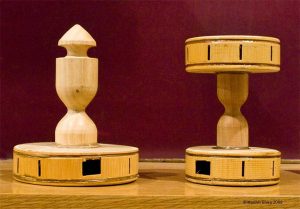One of the favored sports in China is messing about with the Chinese yoyo 抖空竹 dǒukōngzhú. The essential yoyo is formed like two disks connected by an axle and is spun by a string wound around its center and by pushing and pulling on the string by moving two sticks. OK, check out the image. The player moves his hands back and forth or up and down con, this creates a spring-like tension on the yoyo, and it spins.
It may confuse you to recollect that I said two disks connected by an axle. This is often far more challenging but allows certain moves that are impossible with the 2 sided yoyo.
There are samples of the first sort of Chinese yoyo made from bamboo in the picture below. The one on the proper may be a two-sided yoyo, and therefore the one on the left is one-sided. The foremost common Chinese name for the yoyo is 空竹 (kōngzhú) which suggests hollow bamboo and springs from this sort of yoyo.
There are many names for the yoyo, partly because it’s been around for such a long time and partly because it has had many regional nicknames for so long. It also can be called 空钟 ( kōngzhōng) or hollow bell. You’ll see that the only-sided type seems like a bell, but the name could also come from the very fact that when the yoyo is spun, it makes a whistling sound.
Two other names derive from the power to form a sound. Xianghuang 响簧 (xiǎnghuáng) means “make the sound of the woodwind” pertaining to the reed in specific instruments. Cheling 扯铃 (chělíng) means “pull the bell.”
When the yoyo visited Europe with the traders after the 17th century, it got new names. Devil on two sticks must describe the problem of learning the skill. Nevertheless, it became enormously popular among both adults and youngsters. It had been introduced to the circus, where jugglers developed elaborate tricks and feats of skill.
In 1906, Gustav Philippart patented significant design changes to the Chinese yoyo, calling it a diabolo. He had open cups at either end and was made from tire rubber. It might be incorrect to call the kongzhu or Chinese yoyo a diabolo, that name should apply to Philippart’s invention, but many sources ask it as a diabolo. The diabolo’s design is significantly different, although it’s still played with two sticks and a string. Interestingly, Philippart’s version has also been adopted by the Chinese, together with several versions they use.
Chinese yoyo tricks
The Chinese yoyo is a type of yoyo that uses two sticks and a string. It’s a pro-yo-yo but is greater, and therefore, the cups are larger and made out of plastic. As a beginner of diabolo, it isn’t easy to urge the hang of things. But, once you get good at it, you’ll become a Diabolo master.
- To always practice
- Work hard
- Have plenty of patience
- Don’t hand over
Chinese yoyo diabolo
Often called the Chinese Yo-Yo, the diabolo may be a challenging yet fun skill toy. Once the diabolo is spinning, it’ll balance the string suspended between the 2 sticks. Then, with practice, a performer can loop, hop, flip, throw, catch, etc., the diabolo to top that last trick learned or for the amazement of an audience.
How to use a Chinese yoyo
• Making the yoyo spin
• Adjusting: fixing the lean
• Getting more speed
• Throwing and catching
First, we’ll get to get the yoyo spinning. Hold the sticks in one hand, and place the yoyo within the string between the sticks. Now put the yoyo on the bottom, and hold the sticks together with your two hands (about body width apart, and keeping the string slightly taut) so that string is open (you can see the axle of the yoyo with no string over it). Position yourself so that the yoyo is ahead of you and to the proper.
Now, roll the yoyo to the left (in front of you) and lift it with both hands in order that the yoyo is off the bottom. Next, pull straight up with the proper stick and then, without force, return it to its starting position. Imagine trying to start up an old-fashioned lawnmower with the facility chord.
The left can move right down to accommodate the pull, however, attempt to use as little force as possible to return it to its starting position. Continue pulling with the proper hand, and do not pull with the left. The left only “rebounds” to its starting position without actually pulling. It’s there to get rid of the slack of the string when the proper hand drops down. this may take a while to urge won’t to.
Some points to remember:
1) The faster the yoyo spins, the more stable it’s.
2) Keeping the yoyo level (parallel to the ground) is imperative. (do this by adjusting or utilizing)
3) Stay “behind” the yoyo, i.e., the side of the yoyo should be parallel with the plane of the body (always with the string open).
4) Pulling the proper stick “in the plane of the yoyo” helps keep the yoyo level (the “plane of the yoyo” is that the plane that’s formed by the middle of the yoyo, and therefore the tips of the 2 sticks; this plane should be perpendicular to the ground).

